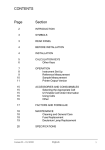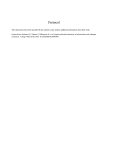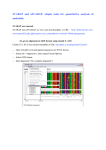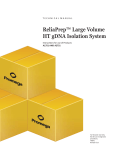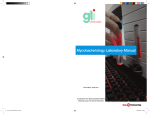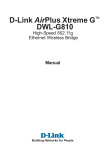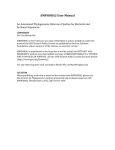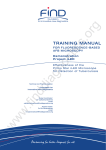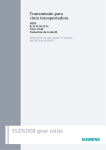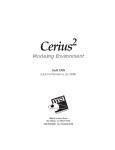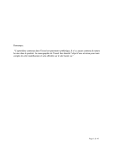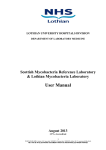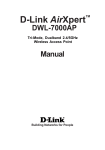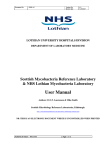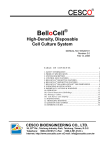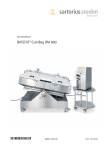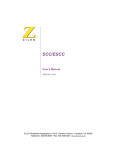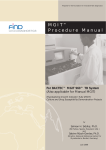Download PDF
Transcript
STUDY PROTOCOL XpertTM MTB/Rif Demonstration Feasibility, impact and cost-efficiency of decentralizing molecular testing for detection of tuberculosis and rifampicin resistance using XpertTM MTB/Rif Version and date: 1.0 / 04 April 2009 Project and study: Cepheid / 7210-3/1 Trial sites: South Africa, Peru, Philippines, Uganda, India, Azerbaijan Study Coordinator: Dr. Catharina Boehme email: [email protected] tel: +41 22 710 93 16 Project Leader: Dr Ranald Sutherland email: [email protected] tel: +41 22 710 09 53 CONFIDENTIALITY STATEMENT: The information contained in this document, especially unpublished data, is the property of FIND (or under its control) and may not be reproduced, published or disclosed to others without written authorization. 2 TABLE OF CONTENTS TABLE OF CONTENTS _________________________________________________________ 3 PARTNER INSTITUTIONS _______________________________________________________ 4 STATEMENT OF INVESTIGATORS _______________________________________________ 5 PROTOCOL SYNOPSIS ________________________________________________________ 6 DEMONSTRATION STUDY PROTOCOL __________________________________________ 11 BACKGROUND ______________________________________________________ 11 RATIONALE _________________________________________________________ 15 STUDY DESIGN ______________________________________________________ 16 Patient inclusion criteria ________________________________________________ 18 Patient exclusion criteria ________________________________________________ 19 Laboratory requirements ________________________________________________ 20 MINIMIZATION OF BIAS _______________________________________________ 22 STUDY COORDINATION, TRAINING AND MONITORING _____________________ 22 ETHICAL CONSIDERATIONS ___________________________________________ 23 ANNEX 1: Proficiency testing form ________________________________________________ 24 ANNEX 2: User appraisal questionnaire ____________________________________________ 28 ANNEX 3: Process controls _____________________________________________________ 32 ANNEX 4: Sputum collection ____________________________________________________ 33 ANNEX 5: Sputum decontamination for culture & microscopy (Kubica) ____________________ 34 ANNEX 6: Semi-quantitative mycobacterial smear____________________________________ 36 ANNEX 7: Semi-quantitative mycobacterial culture ___________________________________ 38 ANNEX 8: Speciation with Tauns Capilia TB ________________________________________ 42 ANNEX 9: Drug susceptibility testing ______________________________________________ 44 3 PARTNER INSTITUTIONS 1. South Africa (2 sites) Ministry of Health and National TB Programme (NTP) National Health Laboratory Services (NHLS) South African Medical Research Council (SAMRC) University of Cape Town (UCT) Médecins Sans Frontières 2. Peru (2 sites) National TB Programme (NTP) & Instituto Nacional de Salud (INS) Instituto de Medicina Tropical “Alexander von Humboldt “, Universidad Peruana Cayetano Heredia (UPCH) 3. Philippines (1 site) National TB Programme (NTP) Tropical Disease Foundation (TDF) Center for Disease Control, Atlanta 4. India (1 site) Central TB Division (CTD) CMC Vellore FIND India 5. Uganda (1 site) National TB Programme (NTP) Infectious Diseases Institute (IDI) University of California (UCSF) FIND Uganda 6. Azerbaijan (1 site) Main Medical Department (MMD) Ministry of Health (MOH) Special Treatment Institution for Detainees with Tuberculosis (STI) 4 STATEMENT OF INVESTIGATORS In signing this page, I agree to conduct the study in accordance with the relevant, current protocol, applicable regulations and institutional policy. I will ensure that the requirements relating to obtaining the Institutional Review Board (IRB) review and approval are met. I will promptly report to the IRB all changes in research activity. I agree to notify FIND prior to making any changes in the protocol. I have understood that the XpertTM MTB/Rif Assay is a new technology with highly promising performance characteristics in reference settings. The herein described demonstration study is designed to establish performance characteristics and effectiveness data in decentralized laboratories. These demonstration study data will be compiled and reported by FIND to national TB programs and public health authorities as well as the WHO Stop TB Department, in order to generate informed policy decisions. As such, use of the XpertTM MTB/Rif Assay outside of the frame of this controlled demonstration study in decentralized laboratories, should only be implemented subsequent to the policy decision of the appropriate national health authorities and/or WHO recommendations. I shall maintain confidentiality concerning the contents of the protocol and all other written materials relevant to the demonstration study. I agree to ensure that all colleagues and employees assisting in the conduct of the study are informed about their obligations in meeting all of the above requirements. 5 PROTOCOL SYNOPSIS Background Commercial nucleic acid amplification tests (NAAT) for the detection of tuberculosis (TB) and rifampicin resistance have come into routine use in reference laboratories because of their great advantage of speed compared to culture. However, the complexity of existing commercial NAAT formats, the labor demands, and the need for a high degree of technical support and well-trained staff make them unsuitable for decentralized settings. FIND has signed a development agreement with Cepheid to deliver a fully automated molecular platform for TB case detection and rifampicin resistance testing for high-endemic countries. It is designed to purify, concentrate, amplify and identify targeted rpoβ nucleic acid sequences, and provides results from unprocessed samples in less than 2 hours, with minimal hands-on technical time. After completion of development, the assay has undergone clinical validation in a statistically powered number of patients in reference settings in South Africa, India, Peru, Germany and Azerbaijan. As outlined in more detail in the study protocol below, Xpert™ MTB/Rif performance characteristics were assessed in approximately 4500 sputum specimens from 1500 TB suspected patients. The assay was found to be highly specific and sensitive, detecting M. tuberculosis (MTB) DNA in almost all smear-positive sputum specimens and a high percentage of smear-negative, culture-positive specimens. Rifampicin resistance was detected with high accuracy. In collaboration with National TB Programs and partner institutions, FIND will now explore the feasibility of decentralized use of Xpert™ MTB/Rif to improve TB and MDR TB control. Large-scale demonstration projects are required to provide the evidence that this new diagnostic test can successfully be implemented and have significant medical and public health impacts in programmatic settings. Data from these projects will be shared with the WHO Stop TB Department that is expected to issue guidance on the use of this assay in 2010. Following established procedures, WHO will convene an Xpert™ MTB/Rif committee to review available data on the use and performance of the Xpert™ MTB/Rif and draw up guidelines for the implementation of the assay in low and middle income countries. This guidance will be reviewed by the WHO Strategic and Technical Advisory Group (STAG) for TB in June 2010. Subsequent to STAG approval, WHO will issue formal guidance. Project purpose The purpose of this demonstration project is to assess the implementation of Xpert™ MTB/Rif in decentralized laboratories in low- and moderate-income settings. The project aims at a) confirming the Xpert™ MTB/Rif performance in decentralized laboratories and b) demonstrating the feasibility, impact and cost-efficiency of using Xpert™ MTB/Rif at lower levels of the health system for enhanced detection of smear-negative TB and MDR TB. The data will be reported to national public health authorities and WHO in order to inform policy decision. 6 Study hypothesis Fully automated molecular testing with integrated specimen processing by Xpert™ MTB/Rif is easy and robust enough to be decentralized and allows to significantly increase case detection rates for TB and MDR TB, as well as to shorten time to treatment initiation in comparison with the conventional diagnostic algorithm. Patient management based on a single Xpert™ MTB/Rif test, carried out while the patient is waiting for his/her result, decreases the dropout rate prior to diagnosis and the costs and barriers for the patient. The introduction of such testing is costeffective for the health system when compared to conventional culture and DST costs. Setting of use The demonstration project will primarily assess the feasibility of using Xpert™ MTB/Rif in (sub-) district laboratories. These are defined for study purposes as TB laboratories with a minimum workload of 600 sputum samples per month, with continuous power supply, a minimum of two rooms and at least two well-trained TB staff (microscopist or laboratory technician). Qualityassured routine use of ZN or FM microscopy and access to conventional culture and drug susceptibility testing (DST) are required. Participating laboratories will not have any prior experience with molecular testing. All satellite clinics sending diagnostic requests to participating laboratories will be integrated in the study and will be important for patient data collection. Primary endpoints (all sites) 1. Clinical performance Determine sensitivity and specificity compared to central culture and DST (preferable on liquid media). • Measure increased yield in TB and MDR TB case detection rates compared to local routine diagnostic algorithm 2. Operational performance • Assess robustness of Xpert™ reagents and equipment (temperature, dust, power irregularities, contamination rates, indeterminate results) • Determine maintenance and customer support needs, as well as • Determine minimal training needs through user proficiency testing tool • Confirm established biosafety needs and the ease of waste management • Assess user appraisal through user appraisal questionnaire • Develop recommendations on how to integrate automated molecular testing in resource – poor countries using existing diagnostic algorithms for case detection and MDR TB screening. 3. Impact • Time to detection of TB and MDR TB compared to local routine diagnostic algorithm • Time to reporting of Xpert™ MTB/Rif results compared to conventional results • Time to initiation of appropriate treatment 4. Cost-efficiency • Quantify “per test” and “per patient” costs for the health system compared to routine culture and DST 7 • Secondary endpoints (optional) 1. Impact • Patient dropout rate prior to diagnosis • Mortality for enrolled patients during follow up • Hospitalization frequency and duration • Time to return to work 2. Cost-efficiency • Quantify costs to the health system and assess cost-effectiveness of Xpert MTB/RIF testing compared to baseline (instead of and in addition to scenarios) • Establish innovative partnership models that increase cost-efficiency, impact and sustainability of Xpert™ MTB/Rif testing (integrating TB screening in HIV care in Uganda and South Africa) Sample size The sample size for this study is largely a reflection of WHO’s requirement to see a new test evaluated in a geographically and otherwise representative number of routine settings. The sample size calculation was largely driven by the need to assess Xpert in a variety of different settings representative of the real-world situation in high burden countries. It will be important to determine how dependant Xpert performance is on population factors (notably HIV prevalence), daily workload, user skills and laboratory infrastructure aspects. We will have to assess whether the rate of DNA contamination goes up over time, to follow the evolution of sensitivity and specificity and the impact of laboratory technician’s fatigue, and to monitor the robustness of the assay in the field (error rate, instrument robustness). All these endpoints require longer study duration and a variety of sites. Xpert sensitivity and specificity estimates were the primary endpoints for the minimum sample size calculation during phase 1 (validation phase). Based on discussions with the participating centers, we assumed a minimum average daily enrolment number per site of 5 patients and an average TB prevalence of 15%. The following minimum performance criteria were set as go/no go decision criteria for moving to the next project phase a) Xpert™ MTB/Rif sensitivity > 80% of culture positive cases (this should be the lower limit of the confidence interval) b) Xpert™ MTB/Rif specificity > 90% of culture negative cases (this should be the lower limit of the confidence interval) For each site, enrolling 380 patients would provide 57 confirmed TB cases. A sensitivity of 90% or above would produce a lower confident interval limit of at least 80%. Of the 323 remaining, 5-10% would be of indeterminate diagnosis. However, only 55 TB negative patients are sufficient to have a lower confidence interval limit of at least 90% with given the expected specificity of 98%. 8 This would leave us with an overall sample size need of 2660 TB suspects for phase 1 and an enrolment duration for this phase of 3 months. The overall sample size for the study (all phases) was also determined by Rifampicin resistance endpoints. While the expected sensitivity is 95%, the lower limit of the confidence interval should be at least 92% requiring at least 315 Rif-resistant cases among culture positives. With an MDR prevalence rate of 5% across all sites, this would require a total enrolment of 6300 TB suspects. Equipment and reagent needs* South Peru Philippines India Uganda Azerbaijan Africa GeneXpert 3 3 2 1 1 1 Xpert™ 2160 2160 720 1140 720 720 MTB/Rif Total 9 instruments and 7620 tests *including already available instruments from previous study Study Phases All sites (except South Africa) Study phase Duration # sputa per patient Methods at Demo Lab Methods at Ref Lab Treatment decision based on: FU at Clinic Training 1-3 days Validation 3 months Requires at least 32 sputum samples with known smear, culture and Rif result stored at -20°C. Case Routine ZN Culture & Routine smear As per routine and detection: 2-3 Xpert™ DST (culture) for Xpert™ MDR risk: 2-3 MTB/Rif MDR risk: MTB/Rif or culture Routine DST pos patients after (Possible: 2 and 6 months. culture) Implementation 3 months Case detection: 2-3 MDR risk: 2-3 ZN Xpert™ MTB/Rif Culture & DST Continuation 6 months Case detection: 1 MDR risk: 1 (2 if Rif res) ZN Xpert™ MTB/Rif Selected DST for Xpert-Rifres cases Xpert weeks Routine weeks Smear Xpert™ MTB/Rif (case detection only) Selected DST for Rif res Smear Xpert™ MTB/Rif Selected DST for Rif res As per routine and for Xpert™ MTB/Rif or culture pos patients after 2 and 6 months Treatment decision based on: FU at Clinic As per routine and for Xpert™ MTB/Rif pos patients after 6 months. South Africa Study phase Duration # sputa per patient Training 3-5 days Requires 32 sputum samples with known smear, culture and Rif result stored at -20°C. 9 Phase I (reported in this Lancet manuscript) 6 months 2 Phase II (ongoing) 12 months 1-2 Xpert™ MTB/Rif plus Auramine smear (1 smear) plus culture Xpert™ MTB/Rif Auramine smear (2 smears) plus culture Smear, culture Xpert™ MTB/Rif DST for all cultures As per routine and for Xpert™ MTB/Rif or culture pos patients after 2 months Standard diagnostic algorithm (Auramine smear plus selected culture) Smear, culture Xpert™ MTB/Rif Selected DST for Rif res As per routine and for Xpert™ MTB/Rif pos patients after 2 months. Timelines Activity / Event IRB approvals Shipment of GeneXpert instruments & cartridges Validation Phase - enrolment Implementation Phase – enrolment Continuation Phase WHO expert committee meeting 10 Date By May 09 May 09 Jun – Aug 09 Sep – Nov 09 Dec 09 – Jun 10 Apr 10 (possibly Sep 10) DEMONSTRATION STUDY PROTOCOL BACKGROUND Despite the enormous global burden of TB, approaches to TB diagnosis still rely on traditional methods that have major limitations. The disproportionate amount of smear-negative disease in sub-Saharan Africa, which shoulders two-thirds of the global burden of HIV/AIDS, has greatly complicated TB case detection and disease control. Multidrug-resistant (MDR) TB, defined as resistance to both isoniazid and rifampicin, two of the most important “first-line” anti-TB drugs, is a rapidly growing problem, especially in Eastern Europe and countries of the former Soviet Union. Even more alarming is the recently documented phenomenon of XDR (or extensively drug-resistant) TB, defined not only as resistance to isoniazid and rifampicin but also to one second line injectable agent and a fluoroquinolone antibiotic. XDR TB is often not curable with available drugs. The low sensitivity of smear microscopy limits its impact on TB control. Culture methods are complex, slow and still only scarcely available in high endemic-countries. Drug susceptibility testing is even slower and more technically complex. While patients await diagnosis, their disease progresses with an increased chance of dying from tuberculosis and they continue to transmit drug-resistant TB to others, especially family members. Early case detection is essential to interrupt transmission and to prevent the further spread of tuberculosis and multidrug-resistant tuberculosis. A new diagnostic approach is therefore urgently needed. Only a small fraction of the estimated 489,000 MDR TB cases occurring each year have access to drug susceptibility testing DST. Key obstacles to DST expansion over the past years were 1) the complexity of available tools and the laboratory infrastructure required for their implementation; 2) the unaffordable price of better (but equally complex) technologies; and 3) the unavailability of rapid and simple tools for identification of resistance. Although nucleic acid amplification tests (NAAT) for the rapid detection of TB and rifampicin resistance exist, their complexity, along with the labor demands, including the need for a high degree of technical support and well-trained staff, make them suitable for central reference laboratories only. FIND has signed a development agreement with Cepheid to deliver a fully automated molecular platform for TB case detection and drug resistance testing for high-endemic countries. It is designed to purify, concentrate, amplify and identify targeted rpoB nucleic acid sequences, and delivers answers from unprocessed sputum samples in 120 minutes, with minimal hands-on technical time: DESCRIPTION OF Xpert™ MTB/Rif TEST The Xpert™ MTB/Rif assay performed on the GeneXpert™ MTB/Rif system is a rapid test for the detection of M. tuberculosis (MTB) and rifampicin resistance. The GeneXpert™ system consists of a GeneXpert instrument, personal computer and disposable fluidic cartridges. The system combines cartridge-based sample preparation with amplification and detection in a fully integrated and automated nucleic acid analysis instrument. 11 The manual sample pre-treatment for the assay is simple: Sample treatment buffer is added to sputum samples and a defined volume of this mixture is then transferred to the sample chamber of the cartridge. The cartridge is then inserted in the GeneXpert™. From this point on, all steps are automated: GeneXpert™ first captures MTB organisms from the sputum sample on a filter membrane. Inhibitors are then washed from the captured cells with buffer. Finally the captured, washed cells are lysed with ultrasonic energy, and the released DNA eluted through the filter membrane. The DNA solution is finally mixed with dry PCR reagents and transferred into the PCR tube for real-time PCR and detection. To eliminate test-to-test contamination, all fluids - including amplicons - are contained within the disposable cartridge. Concentrates bacilli & removes inhibitors End of hands on work 3 Sample is automatically filtered & washed Ultrasonic lysis of filtercaptured organisms to release DNA 5 4 DNA molecules are mixed with dry PCR reagents 6 GeneXpert Transfer of 2 ml after 15 min 2 Semi-nested real-time amplification & detection in integrated reaction tube Time-to-result: 1 h 45 min 7 1 Sputum liquefaction & inactivation with 2:1 SR Printable test result Figure 1: Xpert™ MTB/Rif assay procedure Each instrument contains 4 individually accessible modules that are capable of performing separate real-time polymerase chain-reaction (PCR) protocols. Other instrument sizes are available containing between 1 and 72 individually accessible modules. Each module consists of a syringe drive for dispensing fluids, an ultrasonic horn for lysing cells, a thermocycler, and optical signal detection components. The single-use cartridges contain i) chambers for holding sample and reagents, ii) a valve body composed of a plunger and syringe barrel, iii) a rotary valve system for controlling the movements of fluids between chambers, iv) an area for capturing, concentrating, washing and lysing cells, v) lyophilized real-time PCR reagents and wash buffers and vi) an integrated PCR reaction tube that is automatically filled by the instrument. 12 The assay is based on multiplex, nested real-time PCR. A series of molecular beacons 1 is used to simultaneously detect the presence of MTB and to diagnose rifampicin resistance as a surrogate marker for MDR disease. Species-specific primers allow amplification of the MTB rpoB core region. Nested PCR is used in order to increase the sensitivity of the assay. Up to six target sequences can be detected simultaneously with the six color assay: one of the six molecular beacon probes was designed to detect DNA of the sample processing control Bacillus globigii; the other five molecular beacons are designed to hybridize to overlapping segments of the rpoB core region – the amplicon. The analytic sensitivity of the real time PCR reaction was found to be 4.5 genomes per assay using genomic DNA. Spiking M. tuberculosis organisms into negative sputum in dilutions at 10 to 300 cfu per reaction in replicates of 20 found a limit of detection of 131 cfu per assay. In wild-type M. tuberculosis, the rpoB core region is highly conserved but is mutant in 95% of rifampicin-resistant MTB. The presence of all five fluorescence signals indicates that rifampicinsusceptible MTB DNA has been detected. At least two but less than five fluorescence signals indicate the presence of rifampicin-resistant MTB. The presence of a single fluorescence signal (in addition to the signal for the sample processing control) is interpreted as an invalid result since experience has shown that even the most mutant MTB isolates produce at least two positive signals. No fluorescence signal from one or fewer of the rpoB probes indicates absence of MTB DNA (the positive signal for the internal process control indicates that the assay worked). Spiking M. tuberculosis DNA containing clinically relevant mutations into the cartridges that were then run with M. tuberculosis-negative sputum demonstrated the ability to pick up all rpoB mutations reported to be present at a frequency at least 0.5% of all rifampicin-resistant strains worldwide, calculated by compiling sequence frequencies from 78 separate studies of over 4000 rifampicin-resistant strains. More detailed information can be shared as soon as the data have been published (David Alland; data submitted for publication). 1 Molecular beacons are single-stranded nucleic acid molecules that possess a stem-and-loop structure. The loop portion of the molecule serves as a probe sequence that is complementary to a nucleic acid target sequence. Short complementary “arm” sequences bind to each other to form the stem hybrid. A fluorophore is covalently linked to the end of one arm and a nonfluorescent quencher to the end of the other arm. When the molecular beacon hybridizes to its target, the stem helix is forced apart and the fluorophore is separated from the quencher, permitting the fluorophore to fluoresce when excited by light of an appropriate wavelength. 13 CLINICAL PERFORMANCE OF Xpert™ MTB/Rif TEST After completion of development, the assay has undergone clinical validation in a statistically powered number of patients in reference settings in South Africa, India, Peru, Germany and Azerbaijan. As summarized in the table below, the Xpert™ MTB/Rif assay was found to be highly sensitive and specific, detecting M. tuberculosis DNA in almost all smear-positive sputum specimens and a very high percentage of smear-negative, culture-positive specimens. Rifampicin resistance and MDR was detected with high accuracy. Assay performance even remained good when analyzing a single Xpert™ MTB/Rif result in comparison to 4 culture results per patient. The performance was very homogenous across countries. Total Sensitivity in S+C+ 99.5% [98.4% - 99.8%] Sensitivity in S-C+ 90.0% [84.6% - 93.7%] Specificity in Non-TB 97.9% [96.4% - 98.8%] Table: Per patient analysis, Xpert™ MTB/Rif sensitivity and specificity (3 Xpert, 3 smears, 4 cultures), preliminary study results. Total Sensitivity in Rif resistant cases Sensitivity in MDR cases Specificity in Rif sensitive cases 96.1% [92.4% - 98.0%] 96.5% [93.0% - 98.3%] 98.6% [97.2% - 99.3%] Table: Per patient analysis, Xpert™ MTB/Rif sensitivity and specificity for Rif and MDR detection (3 Xpert, 3 smears, 4 cultures), sequencing data not taken into consideration; preliminary study results. In conclusion, Xpert™ MTB/Rif was not only suited for rapid MDR screening, but also seemed very useful for early case detection in smear negative TB patients. The high accuracy of a single Xpert™ MTB/Rif result per patient and the time to diagnosis of below 2 hours should allow for on-the-spot diagnosis and TB treatment initiation based on one Xpert™ MTB/Rif result only. These findings need now to be confirmed in the intended setting of use. We will inform you as soon as the submitted manuscript with evaluation study results has been accepted for publication. OPERATIONAL PERFORMANCE OF Xpert™ MTB/Rif TEST During the evaluation studies, the indeterminate rate for Xpert™ MTB/Rif was <5% at all sites. This was equal or lower than the indeterminate rate for culture. The overall indeterminate rate fell to 1.1% if successful repeats were counted. The assay performed equally well on both, NALC-NaOH processed sputum and untreated sputum samples. Xpert™ MTB/Rif was designed as a closed system to reduce or eliminate the risk of amplicon contamination. Once closed, the cartridges are never reopened. The Xpert™ MTB/Rif cartridge works by trapping bacteria, and in the first wash step, free DNA is removed to the waste chamber. Inoculation of small amounts of free M. tuberculosis DNA into non-infected sputum and loading in the Xpert™ MTB/Rif does not result in positive assay results. No false-positive results have occurred in tests on healthy subjects. During evaluation studies with sample workloads of up to 40 specimens per day, the demonstrated specificity was high. 14 The users regarded the minimal manual sample pretreatment as easy and suitable for the microscopy center level. This 15 min sample pre-treatment was found to be capable of inactivating up to 107 AFBs spiked. In addition, aerosol studies showed that significantly fewer aerosols are produced during sample pretreatment for Xpert™ MTB/Rif than during preparation of direct smears. No infectious aerosols were found to be released from cartridges even for input of up to 108 AFBs. In conclusion, the sample pre-treatment steps for Xpert™ MTB/Rif can be performed without biosafety cabinet on an open bench during demonstration studies. Only laboratories, which have biosafety cabinets (BSC), and are currently preparing microscopy smears in the BSC, will carry out the sputum pre-treatment steps for Xpert™ MTB/Rif in the BSC. The GeneXpert™ instrument will be placed in a general purpose laboratory without biosafety facility in all settings. No live bacteria have been recovered from spent cartridges, but it will be recommended to autoclave cartridges as well as sputum containers for the demonstration project. No live bacteria have been recovered from spent cartridges, but autoclaving is recommended. Laboratories currently doing NALC/NaOH treatment of sputum for culture may use the pellet for testing in Xpert™ MTB/Rif without the need to split the raw sputum prior to treatment. RATIONALE In response to the growing problems of MDR and XDR TB, as well as the continuing epidemic of HIV-associated TB, WHO and its partners have called for greatly enhanced global capacity for mycobacterial culture and DST as well as for implementation of rapid methods for screening for MDR TB.i This massive scale-up is thought to require that up to 2000 new culture-capable TB laboratories be established and 10,000 new laboratory workers be trained by 2015. It is possible that much of this needed capacity could be addressed by molecular tests for case finding and MDR TB detection. With the WHO endorsement in 2008 of line probe assays (LPAs) for MDR TB screening, many countries are implementing this system. However, as noted above, the test is sufficiently complex that decentralized testing is not feasible. Therefore, the Xpert™ MTB/Rif assay is of great interest as it provides for highly accurate and simplified testing at a much lower level of the health system. Although it provides information only on rifampicin resistance (in addition to detection of M. tuberculosis complex), in nearly all settings rifampicin resistance is an accurate surrogate for MDR TB. Although good performance of the Xpert™ MTB/Rif assay has been demonstrated in carefully controlled laboratory settings, data on testing in program conditions, as well as information about cost and patient/public health impact, are needed to inform public policy on the use of the system. These demonstration projects are intended to provide this information. 15 STUDY DESIGN After having confirmed that assay performance targets are met in reference laboratories, FIND will now explore the feasibility of decentralized use of Xpert™ MTB/Rif to improve TB and MDR TB control. In collaboration with National TB Programs and partner institutions, large-scale demonstration projects will be carried out to provide the evidence that this new generation of NAAT can be successfully implemented in regional and (sub-) district laboratories – and even microscopy centers – and have significant medical and public health impacts in programmatic settings. The demonstration project will primarily assess the feasibility of using Xpert™ MTB/Rif in (sub-) district laboratories. Whereas the Xpert™ MTB/Rif assay is implemented and used at the (sub-) district laboratories, the reference laboratory will be responsible for performing culture and phenotypic DST. For study purposes, a supervisory site will be assigned for each participating (sub-) district laboratory (= demonstration site) with its satellite clinics. This supervisory site will ensure protocol and GCLP compliance and will be responsible for local project coordination and data management. The supervisory site can, but does not have to be the reference laboratory. Criteria for country selection • • • • • • • Agreement at National Level (MOU with NTP, NRL or MOH) High-burden of TB Low or middle income At least 2 countries with high HIV prevalence (and high prevalence of smear negative TB) At least 2 countries with significant MDR prevalence Local presence of FIND or implementing partner Representative of global TB situation Criteria for selection of microscopy centers National TB Programs will select the demonstration sites that shall participate in the project and will base their selection on the following criteria: • Selected demonstration sites must be easily accessible by monitors from the respective supervisory site • Must have at least 10-15% smear positivity • Must have at least 2 rooms • Ideally, should have a minimum of 150 sputum samples eligible for Xpert testing • 2 microscopists or laboratory technicians present, with no prior experience with molecular biology 16 Country / Location Level of the Primary Average # Electricity Biosafety Site health system Use smears/day cabinet Lima, Peru (supervised: by Instituto Nacional de Salud and Universidad Peruana Cayetano Heredia) HSJL Urban District Hospital Case 25 Stable with BSC 1 (ZN, Ogawa) detection occasional short interruptions CSPL Urban Health Center Case 15 Stable with No (ZN) detection occasional short interruptions HXV Suburban Health Center Case 12 Stable with weekly No (ZN) detection short interruptions Vellore, India (supervised by Christian Medical College, Vellore) CHAD Suburban Health Center Case 20 Stable with daily No (ZN) detection short interruptions Baku, Azerbaijan STI Urban Referral Center MDR 60 Stable weekly BSC 1 (ZN, LJ, MGIT) detection short interruptions Cape Town, South Africa (supervised by NHLS laboratory Groote Schuur and University of Cape Town) Paarl Urban Provincial Case 300 Stable with weekly BSC 1 Laboratory (FM) detection short interruptions MSF KH Urban Health Center Case 30 Stable with weekly BSC 1 (FM) detection short interruptions Kampala, Uganda (supervised by National Reference Laboratory and FIND Uganda) Mulago ER Urban Referral Case 30 Stable with weekly No Hospital, detection short interruptions Emergency unit (ZN) Manila, Philippines (supervised by Tropical Disease Foundation) LCP Urban Referral Hospital MDR 10 Stable BSC 1 (ZN, Ogawa) detection Infrastructure Access to treatment 1 lab room, 1 storage room TB; MDR 1 lab room TB; MDR 1 lab room TB; MDR 1.5 lab rooms TB (MDR in Chennai) 4 lab rooms TB; MDR 3 lab rooms TB; MDR 2 lab rooms TB; MDR 1 room TB 3 rooms TB; MDR Table. Sites description Study phases all sites (except South Africa) The project will be split in the following study phases: 1. Training & proficiency testing (1-3 days): During the on-site training phase, lab technicians from the (sub-) district laboratory and the supervisor from the reference laboratory will receive training on the Xpert™ MTB/Rif assay from the FIND study team. Before the training begins, a quality income check will be performed to ensure that cartridges and the GeneXpert™ are working properly. The actual testing will only start once Cepheid has approved the QC income check. At least 32 tests will be performed per site to gain practical experience and to determine the proficiency of the users. This will be followed by proficiency testing with 4 well characterized samples per user. The required frozen sputum samples will be collected and stored at the site before the training begins. Training will also comprise other study related aspects such as study-specific workflow and data management. Oral and written feedback on overall impression of the assay will be provided by the training participants in the form of a user appraisal questionnaire. 2. Validation Phase (at least 3 months enrolment): This study phase aims at the collection of baseline data for the routine diagnostic algorithm prior to intervention and at the validation of Xpert™ MTB/Rif performance in this new environment. The routine diagnostic algorithm at participating laboratories will be maintained, except that one Xpert™ MTB/Rif is done along with ZN. In addition, culture and DST for at least rifampicin and isoniazid will be performed for one untreated leftover sample per patient by the reference laboratory. This will provide the comparative gold standard. Patient 17 management however, will only be based on routine results, not on the Xpert™ MTB/Rif or the gold standard result. A patient follow-up visit after 2 months and 6 months for culture or Xpert™ MTB/Rif positive patients is required. Participating demonstration sites will be able to move to the implementation phase, if the following Xpert™ MTB/Rif performance targets are met: c) Xpert™ MTB/Rif indeterminate rate < 5% d) Xpert™ MTB/Rif sensitivity > 80% of culture positive cases e) Xpert™ MTB/Rif specificity > 90% of culture negative cases Data will be reviewed after 4-5 months and review shall include a 3 months enrolment phase. A report summarizing the local findings will be submitted to IRBs for review and approval for the respective sites to move to the implementation phase. 3. Implementation Phase (at least 3 months enrolment): ZN and Xpert™ MTB/Rif are used for TB treatment decisions, but not for MDR management. Culture and DST for at least rifampicin and isoniazid will be performed by the reference laboratory. A patient follow-up visit after 2 and 6 months for culture or Xpert™ MTB/Rif positive patients is required. 4. Continuation Phase (at least 6 months enrolment): ZN and Xpert™ MTB/Rif are used for TB treatment decisions. Conventional DST is done only for Xpert™ Rif resistant cases where this is acceptable for the IRB. Otherwise, DST will have to be carried out as per routine diagnostic algorithm. A follow-up visit after 2 and 6 months for Xpert™ MTB/Rif positive patients is desired. Study phases South Africa only 1. Phase I (at least 6 months enrolment): Consecutive TB suspects are enrolled. The diagnostic algorithm is changed on a weekly alternating schedule: Auramine smear and MGIT culture vs. Auramine smear, MGIT culture and Xpert™ MTB/Rif. DST is done on all culture-positive cases. In all patients with a rifampicin resistant result, the test will be confirmed using Hain MTBDRplus testing for independent confirmation of MDR-TB. Patients will be appropriately referred. In addition, Hain MTBDRplus testing will continue to be used (independently of this study) when indicated, as per current clinical practice. Auramine smear, MGIT culture and Xpert™ MTB/Rif are used for TB treatment decisions. 2. Phase II (at least 12 months enrolment): As for Phase I, however during Xpert week only Xpert™ MTB/Rif to be performed, whilst in the routine week, standard of care to be followed (two sputum smears). In both arms, culture and DST will be performed when routinely requested according to standard diagnostic practice at the sites. For details, see country-specific protocol. 18 Patient inclusion criteria Case detection group • Clinical suspicion of pulmonary TB (cough ≥ 2 weeks) • Age ≥ 18 years MDR risk group - Presenting to the clinic as a possible MDR suspect • Re-treatment cases (PTB within the last year or non-converting PTB case) • Symptomatic contacts of known MDR cases or specific MDR-associated exposures Patients presenting specifically as MDR suspects will be analyzed only for the Rif-detection endpoints and not for TB case-detection endpoints. Patient exclusion criteria • No provision of at least 2 sputum samples Routine symptom screening at participating clinics - Cough ≥ 2 weeks - Age ≥18 years Inclusion criteria: Collection of 2 - 3 sputa as per routine Country : Peru Design: Parallel conduct of routine smear microscopy and Xpert Nr of sputa: 2 (s-m) 3 (s-s-s) 3 (s-s-m) 2 (s-m) 3 (s-m-s) 2 (s-m) Direct Xpert: Sp 2 (m) Sp 1 (s) Sp 1 (s) Sp 2 (m) Sp 1 (s) Sp 1 (s) Routine smear microscopy: 2 direct ZN (Sp 1, 2) 3 direct ZN (Sp 1, 2, 3) 2 direct ZN (Sp 1, 2) 2 direct ZN (Sp 1, 2) 3 direct ZN (Sp 1, 2, 3) 2 FM on pellet (Sp 1, 2)* Culture method*: 1 MGIT (Sp 1) 1 MGIT, 1 LJ (Sp 2) 1 MGIT (Sp 2), 2 LJ (Sp 2, 3) 1 LJ (Sp 1) 1 MGIT (Sp 2), 2 Ogawa (Sp 3) 1 MGIT (Sp 2) DST method: MGIT SIRE MGIT SIRE Indirect LPA, LJ proportion LJ LJ Direct and indirect LPA Azerbaijan Uganda India proportion Philippines South Africa Weekly alternation proportion Figure 2: Study flow. *The first positive culture from each patient will undergo confirmation of M. tuberculosis species by biochemical or molecular methods or by MPT64 antigen detection for study purposes, if MTB confirmation is not done systematically. 19 Laboratory requirements Space The sample processing for the Xpert™ MTB/Rif assay will be done on the open bench in the smear microscopy room or under the same conditions as per preparation of sputum smears. The GeneXpert™ will be set up in a 2nd general purpose room as far as possible. In order to limit the risk of contamination, cultures – where available - should be processed in a different room. Equipment and supplies 1. Equipment & consumables supplied by FIND • Test kits including cartridges, sample treatment reagent and sterile plastic Pasteur pipettes (3-5 ml, with 0.5 ml graduation) • GeneXpert™ device (will remain on site after the study) • Computer • Printer (local purchase) • 2D barcode scanner • UPS 1500 VA (local purchase) • Temperature logs 2. Equipment needed but not supplied by FIND • Adapters for European plug (GeneXpert, computer, printer) • Extension cables depending on set up of equipment • USB memory stick • 4°C refrigerator • Autoclave • 1 timer • Gloves, N95 masks/respirator (recommended) • Sterile plastic Pasteur pipettes (3-5 ml, with 0.5 ml graduation) if pouring of SR not desired • Bleach Reference laboratories need in addition: • Facilities, reagents, consumables and equipment for solid or liquid culture (incubator, centrifuge) • Freezer -20°C for pellets and culture isolates • Cryotubes for storage of pellet and isolates (1.8 ml), cryorack, cryoboxes • Disinfectants • Racks for cryotubes • Sterile plastic Pasteur pipettes (1 ml and 5 ml, with graduation), required to split pellet, for culture etc. 20 DATA ANALYSIS The sensitivity, specificity, predictive values and diagnostic accuracy for Xpert™ MTB/Rif in comparison to culture and DST as the gold standard will be calculated. Analysis will be done per patient applying the following diagnostic rules as outlined in the table below. Additionally, the secondary endpoints time to detection of TB and rifampicin resistance, time to TB treatment and time to MDR treatment, and time to reporting case detection and MDR will be calculated. Time to detection will be calculated for all tests per sputum from the date of the sputum collected on which the test was performed to the date that the result is available. Time to appropriate treatment and time to clinical reporting will be calculated per patient from the time of first sputum collection from the patient. Indeterminate rates will be calculated out of all tests performed. Diagnosis Description Smear-positive • • ≥ 1+ smear (≥10/100 fields) or ≥ 2 scanty-positive smears Smear positives with only negative or contaminated cultures will be excluded from analysis. Scanty-positive smear • • 1-9 AFB per 100 fields ≥ 2 scanty positive smears with 2 negative or contaminated cultures will be excluded from analysis. Culture-positive ≥ 1 LJ and/or MGIT culture growth confirmed MTB complex. Cross-Contamination: A single LJ culture with ≤ 20 colonies or a single MGIT culture with MTB growth ≥28 days per patient will be excluded from analysis. NTM: Specimens with growth of mycobacteria other than MTB complex only will be excluded from analysis. Contaminated culture • • • LJ: Cultures completely overgrown by bacterial or fungal contaminations within 3 weeks (discarded). In case of mixed cultures, isolated MTB colonies transferred to new LJ tube (repeat culture). MGIT: Instrument positivity w/o detection of AFB. Contaminated culture results only, among all available cultures, will lead to exclusion from analysis. Xpert™ MTB/Rif positive Xpert™ MTB/Rif resistant case Xpert™ MTB/Rif invalid case Non-TB case Xpert™ MTB results “TB positive”. Indeterminate cases (excluded from analysis) Excluded from analysis as indeterminate cases will be patients not meeting inclusion criteria or with incomplete case report forms; sputum 1 and 2 collected >7 days away; no culture done; no valid culture result due to contamination; no valid Xpert™ MTB/Rif result; smear-positive, culturenegative; single positive culture with <20 colonies on LJ or >28 days on MGIT; culture-positive at follow-up only; culture-positive but missing speciation; culture-positive but NTM only and discrepant RIF in conventional DST. Xpert™ MTB “Rif resistance detected” Persistent “invalid” or “error” or “no result” after repetition (whenever possible). • Smear negative, culture-negative patient without TB treatment on the basis of clinical criteria. • For Xpert™ MTB/Rif or Culture positive patients and random controls, a follow-up at 2 and 6 months with repeated clinical and bacteriological workup will be required to exclude TB with the highest possible likelihood. Only if the bacteriological work-up remains negative, the patient is called Non-TB. 21 Case report forms (CRFs) will be provided by FIND. The electronic data entry tool for the study will be connected to FIND’s central database through secured VPN access, which will have the advantage that study monitors have continuous access to the electronic data. First data entry will have to be done as soon as results become available (real-time). Second data entry will be done based on completed CRFs. When final culture and DST results are available, final data sets will be generated for analysis. MINIMIZATION OF BIAS Avoiding sampling and selection bias: Consecutive sampling method and communitybased study A consecutive series of patients with typical symptoms of TB will be included. The study group will consist of all subjects who satisfy the criteria for inclusion and are not disqualified by one or more of the exclusion criteria. The vast majority of samples will be collected from out-patients and not from the more severely ill hospitalized patients. Measurement bias: Within-subject comparison and blinded interpretation of results In order to increase the precision of the estimates for the accuracy of the Xpert™ MTB/Rif, the study will be based on a within-subject and on a within-sample comparison. Due to the variability of sputum samples within individuals and within samples themselves, a certain measurement bias cannot be avoided. The Xpert™ MTB/Rif data analysis is not done by the users, but real-time in the Xpert software, based on predefined mathematical algorithms. It will therefore not be necessary to blind the Xpert™ MTB/Rif users against smear or culture results. However, it will be necessary to blind the lab technicians performing smear microscopy against Xpert™ MTB/Rif results. The lab technicians involved in smear microscopy will therefore not have access to the GeneXpert software in order to ensure blinding between the gold standard and the method under investigation. The Xpert™ MTB/Rif results will be documented in a separate result form as the standard methods. Indeterminate or invalid GeneXpert results will be analysed as described above STUDY COORDINATION, TRAINING AND MONITORING FIND is the study sponsor and is responsible for planning, managing and monitoring the study. Dr. Catharina Boehme will be the FIND study coordinator. The site study team will receive technical on-site training by FIND during the study initiation visit. Completion of case report forms (CRF) and data management will be part of the initial training. Staff at clinical enrolment sites will be trained in checking study inclusion criteria, applying questionnaire and will be familiarized with the SOP for sputum collection by the on-site study team. During the study, Catharina will be responsible for troubleshooting and logistical support. Sites will contact Catharina or the designated study monitor by e-mail or telephone if they have any difficulties or questions. Catharina will be the interface with Cepheid for Xpert™ MTB/Rif related issues. Telephone conferences between FIND and study sites will be scheduled once a month. Monitoring site visits and close-out visits will be conducted by FIND. Data from each site will be monitored at 2-week intervals for all sites checking for completion and consistency of all data as well as enrolment targets. During each visit 10% of source data is to be reviewed for consistency with data on CRFs and entered into the database. Additionally, 10% of all completed CRFs are to be reviewed by FIND staff for consistency with 22 data entered into the database. In both cases, an error rate is to be recorded. Error rates >3% of all questions require discussion and review. Error rates of >5% of all questions require immediate CRF re-training. Any errors on primary endpoints are to be discussed with each site and reviewed individually. ETHICAL CONSIDERATIONS During the implementation phase, patient management and TB treatment decisions will be based on Xpert™ MTB/Rif results for case detection and during continuation phase the Xpert™ MTB/Rif results of Rifampicin resistance will also be used for patient managment and the routine diagnostic algorithm will be modified. Ethical approval will therefore be required for all participating sites. However, no informed consent will be sought for this demonstration project and a waiver of informed consent is required based on the study benefits and risks. Benefits & Risks: Numerous published studies and a large-scale FIND demonstration project confirm the high accuracy of rpoB-based tests for rifampicin resistance detection. In June 2008, the Strategic Technical Advisory Group (STAG) of WHO has approved line-probe assays for MDR screening in developing countries. However, this use is restricted to central laboratories due to complexity and biosafety and equipment needs. The Xpert™ MTB/Rif has the additional advantages of simplicity, reduced biosafety needs and much increased sensitivity which should allow using the assay for case detection in smear-negative patients as well as for MDR screening in decentralized settings. All results obtained so far have shown excellent assay performance. Especially during later study phases, patients will receive a better diagnostic work-up than they would under routine conditions. Thus, participation in this project poses no foreseeable risk to patients. Furthermore, investigators will have no direct contact with patients. All data will be obtained from records collected by the clinical and laboratory staff and will be stripped of patient identifiers prior to entry into project databases. No sample bank will be created. The stored pellets and culture isolates will only be needed to resolve discrepant cases. Finally, it must be ensured by all sites that patients diagnosed by Xpert™ MTB/Rif assay, including MDR TB cases, receive appropriate treatment according to program norms throughout the demonstration period. Confidentiality: There are no risks with respect to confidentiality. Patient identifiers will be encrypted. Only authorized medical personnel at the study sites will have access to patient names. 23 ANNEX 1: Proficiency testing form Proficiency testing: Xpert™ MTB/Rif assay Xpert™ MTB/Rif Demonstration Project This tool is intended to be used by FIND monitor and/or study coordinator to assess the minimum training needs and the resulting proficiency of the laboratory technicians at different points during the study. The assessment will be carried out after initial training and at defined time intervals as described in the training plan. The operators will be asked to perform a complete Xpert run as per routine testing. The supervisor will observe, without intervening or correcting mistakes. The testing will be comprised of the following parts: A. Observed hands-on Xpert™ MTB/Rif run. Each operator will be provided with 4 sputa with known results and asked to perform a routine Xpert run. The supervisor will observe the run and complete a proficiency checklist which includes the critical steps that should be performed according to the SOP to ensure reliable test results. B. Questionnaire. These questions should be asked orally during/after the observed hands-on Xpert run to assess the level of understanding of the Xpert™ MTB/Rif assay and the operator ability in coping with problems that might arise during the procedure. C. Assessment of the GX software. Each operator will be asked to perform the most important tasks using the GX software. The supervisor will complete a checklist. D. Appraisal. At the end the FIND supervisor or study coordinator will estimate the level of confidence shown by the operator while performing Xpert and this will be criteria for proficiency. Performance targets The operators will only start performing the Xpert™ MTB/Rif assay if the following performance targets are met: - Individual scores for Part A, B and C ≥ 8 - AND an overall appraisal of the operator’s confidence to perform Xpert of ≥ 4 If performance targets are not met after initial training, the operator will undergo additional training on specific topics until targets are met. Materials needed: - 4 bottles of SR, Xpert™ MTB/Rif cartridges and disposable pipettes 4 viscous/very viscous sputa (1 culture negative, 3 culture positive and among them 2 DST Rif-resistant) Timer 24 A. Observed hands-on Xpert™ MTB/Rif run – Checklist Instructions: Prepare the workspace. Process 4 samples according to the SOP instructions. The FIND monitor or study coordinator that supervises the assessment will complete the checklist. For each correct item, the operator will obtain 1 point. SAMPLE PREPARATION 1. Did the operator add the correct volume of SR? (compared to the YES NO YES NO 3. Was the incubation time 15 minutes? YES NO 4. Was the input volume transferred to the cartridge correct? YES NO 5. Did the operator start each new test in the GX without any YES NO YES NO YES NO YES NO YES NO YES NO reference material sputum cups) 2. Did the operator shake the sample mix 2 times before the end of incubation time? XPERT TEST problem? BLEACH 6. Did the operator clean the work bench with fresh bleach after performing the Xpert™ MTB/Rif assay? STORAGE 7. Are new/unopened Xpert™ MTB/Rif kits stored in a clean and dry place? WASTE 8. Are used Xpert™ MTB/Rif reagents sealed in a plastic bag before discarding? 9. Are all infectious materials (sputum cups, pipettes) properly disposed of? (as per local guidelines for hazardous materials) LAB SETUP 10. Is the workflow in the lab correctly set up to avoid DNA crosscontamination? (Unidirectional workflow from sample preparation area to DNA amplification area) PART A Score / Number of correct items 25 B. Questionnaire Instructions: The FIND monitors or study coordinator that supervises the assessment will ask the following questions to each operator in the context of the Xpert™ MTB/Rif proficiency run. For each correct item, the operator will obtain 1 point. Answered correctly Questions 1. Which are the acceptable ranges for SR and input volume? YES NO 2. For how long is the sample mix (sputum + SR) stable and you can batch samples? YES NO 3. What would you do if you have started a test and realize that you did not enter the sample ID? YES NO 4. What would you do if you drop sputum on the bench and other containers when transferring it to the cartridge? YES NO 5. What would you do if you drop SR and splashed on hands, face and eyes? YES NO 6. What would you do if you dropped a cartridge containing sample mix while transporting it from the sample preparation area to the GeneXpert? YES NO 7. What would you do if the Xpert result is “error”, “invalid” or “no result”? YES NO 8. Which are the biosafety requirements for the Xpert sample preparation step? YES NO 9. What would you do if you receive an error message or if a run is aborted by GeneXpert? YES NO 10. How often do you have to calibrate the GeneXpert? YES NO PART B Score / Number of correct questions 26 C. Assessment of the GX software – Checklist Instructions: When the Xpert proficiency run is over, the FIND monitor or study coordinator will ask the Xpert operator to perform the tasks in the below table. The supervisor will complete the checklist according to the operator’s proficiency to perform each task. For each correct task, the operator will obtain 1 point. Done correctly Task 1. Create a test, enter all the information requested by the software to start a new run YES NO 2. Enter information manually (in case the barcode reader does not work) YES NO 3. Edit the test information (i.e. change the sample ID for a given sample result) YES NO 4. Display test results for a given ID YES NO 5. Archive .gxx files YES NO 6. Retrieve .gxx files YES NO 7. Export test results into a .csv file YES NO 8. Install a new ADF YES NO 9. Create reports: assay definition report and installation qualification YES NO 10. Maintenance – perform plunger rod disinfection, valve maintenance and self-test YES NO APPRAISAL PART C Score / Number of correct tasks How would you evaluate the level of confidence shown by the operator while performing Xpert? 1(not confident) 2 3 4 27 5(very confident) ANNEX 2: User appraisal questionnaire Questionnaire: User appraisal of Xpert™ MTB/Rif assay Xpert™ MTB/Rif Demonstration Project Pre-survey Laboratory ID: ____________________ Country: Date of survey completion: __ __ / __ __ / __ __ (DD/MM/YYYY) Study phase: Training Validation Purpose: To evaluate the usability and of the Xpert TM ____________________ Implementation Continuation MTG/Rif assay and obtain feedback for improvement. Instructions: - To be completed by each Lab technician performing Xpert™ MTB/Rif at the end of each study phase. Please answer all the questions by selecting the most suitable response. Provide comments wherever necessary to aid in understanding or provide additional relevant feedback. General Satisfaction Question 1. Overall, are you satisfied with the performance of the Xpert™ MTB/Rif assay? 2. Do you feel that the Xpert™ MTB/Rif is a practical means of testing for MTB? Response Satisfied Unsatisfied (please explain) Don’t know Yes No (please explain) Don’t know 3. Do you feel that use of the Xpert™ MTB/Rif meets your countries needs? Yes No (please explain) Don’t know Comments Xpert™ MTB/Rif compared to Standard Testing 4. How difficult is use of the Xpert™ More difficult Same MTB/Rif compared to smear Less difficult microscopy? Don’t know 5. How much hands-on time is More hands-on time Same required for Xpert™ MTB/Rif Less hands-on time compared to smear microscopy? Don’t know 6. How difficult is use of the Xpert™ More difficult Same MTB/Rif compared to AFB Less difficult culture? Don’t know 7. How much hands-on time is More hands-on time Same required for Xpert™ MTB/Rif Less hands-on time compared to AFB culture? Don’t know Background 8. How much experience do you have doing smear microscopy? 9. How many years of experience do you have doing AFB culture? 10. During the training/study, approximately how many samples have you personally processed by Xpert™ MTB/Rif? None <6 months <1/week 28 1-20/wk 6mos – 2yrs 20-100/wk 2 – 5yrs >100/wk >5yrs Ease of Use Question 11. How difficult was the installation of the Xpert™ MTB/Rif assay? 12. Which would you use for sample reagent addition? 13. How difficult is the sample preparation (addition of sample reagent) for Xpert™ MTB/Rif? 14. In your opinion, does Xp sample preparation require a biosafety cabinet? 15. How difficult was the first use of the Xpert™ MTB/Rif? 16. How difficult is the Xpert™ MTB/Rif derived waste management? 17. Is the display/software for the Xpert™ MTB/Rif easy to use? 18. Is the automatically printed results report on completion of the assay suitable to you? Response Difficult (please explain) Easy Don’t know/NA Pouring Pipette Comments Difficult (please explain) Easy Don’t know/NA Yes (please explain) No (please explain) Don’t know/NA Difficult (please explain) Easy Don’t know/NA Difficult (please explain) Easy Don’t know/NA Difficult (please explain) Easy Don’t know/NA No, would prefer a different report format (explain) Yes, suitable Don’t know/NA 19. Did you have any technical difficulties during installation or use? No Yes (please describe) ________________________________________________________________________ ________________________________________________________________ Training 20. Did you feel the training you received on the Xpert™ MTB/Rif was satisfactory? 21. How many days of training on the Xpert™ MTB/Rif do you feel are necessary for some one trained in smear microscopy? 22. How many days of training on the Xpert™ MTB/Rif do you feel are necessary for someone trained in AFB culture? Satisfied Unsatisfied (please explain) Don’t know 1 - 3 days 4 - 6 days 7 - 10 days > 10 days 1 - 3 days 4 - 6 days 7 - 10 days > 10 days 23. Are there any topics or specifics in using the Xpert™ MTB/Rif assay which were not included in training that you No Yes (please describe) feel should be included? ________________________________________________________________________ ________________________________________________________________ Additional comments and/or remarks (Please specify in this section any additional issue you would like to point out) ________________________________________________________________________ ________________________________________________________________________ ________________________________________________________________________ ________________________________________________________ 29 Questionnaire: Clinicians appraisal of Xpert™ MTB/Rif assay Xpert™ MTB/Rif Demonstration Project Pre-survey Clinic: ____________________ Date of survey completion: Study phase: Country: ____________________ __ __ / __ __ / __ __ __ __ (DD/MM/YYYY) Validation Implementation Purpose: To evaluate the potential utility of the Xpert TM Continuation MTG/Rif assay in TB diagnosis and treatment. Instructions: - To be completed by clinicians / nurses responsible of TB treatment decisions. Please answer all the questions by selecting the most suitable response. Provide comments wherever necessary to aid in understanding or provide additional relevant feedback. Question 1. Are you confident in the TB detection results? 2. Are you confident in the Rifampicin resistance detection results? 3. Would you use Xpert™ MTB/Rif assay as a factor in starting appropriate TB treatment? 4. Would you use Xpert™ MTB/Rif results alone to start TB treatment? 5. Would you use Xpert™ MTB/Rif results to change TB treatment regimen? 6. Would you use Xpert™ MTB/Rif results in combination with most likely clinical diagnosis (especially in smear negative cases)? 7. Would you use semi-quantitative Xpert™ MTB/Rif results in making clinical decisions? 8. Which clinical decision(s) would be influenced by the semiquantitative result? Response Not confident Confident Don’t know/NA Not confident Confident Don’t know/NA Never Hardly ever Often Don’t know/NA Never Hardly ever Often Don’t know/NA Never Hardly ever Often Don’t know/NA Never Hardly ever Often Don’t know/NA Never Hardly ever Often Don’t know/NA Isolation Follow-up schedule Treatment regimen Hospitalization Other (specify) 30 Comments 9. Role of Xpert™ MTB/Rif assay (Xp) for patients on TB treatment Explanation: At this point, the testing of patients on TB treatment is not indicated according to package insert. Reason, DNA and AFB fragments might still be detected in culture-converted patients. If such patients were tested to determine the resistance status: a) What would be your treatment decision for a patient with “Xp pos, Rif resistance not detected” at month 4 st of 1 line TB treatment? (Culture result is neg) Continue current regimen as planned. Stop current regimen and switch to different regimen Depends on clinic. If clinical suspicion of treatment failure, switch, if no suspicion, stick to current therapy. Don’t know/NA b) What would be your treatment decision for a patient with “Xp pos, Rif resistance detected” at month 4 of 1 line TB treatment? (Smear result is neg) st Continue current regimen as planned. Stop current regimen and switch to different regimen Depends on clinic. If clinical suspicion of treatment failure, switch, if no suspicion, stick to current therapy. Don’t know/NA c) st What would be your treatment decision for a patient with “Xp neg” at month 4 of 1 line TB treatment? Continue current regimen as planned. Stop current regimen and switch to different regimen Depends on clinic. If clinical suspicion of treatment failure, switch, if no suspicion, stick to current therapy. Don’t know/NA 10. Assuming per test costs of 10-20 USD, how would you use this test: Not at all Screening test for TB suspects, replacing smear only. Screening test for TB suspects, replacing culture only. Screening test for TB suspects, replacing both smear and culture. Screening test for high risk groups (e.g. MDR suspects, HIV+ patients, prisoners), replacing smear only. Screening test for high risk groups (e.g. MDR suspects, HIV+ patients, prisoners), replacing culture only. Screening test for high risk groups (e.g. MDR suspects, HIV+ patients, prisoners), replacing both smear and culture. MTB confirmation of positive smear or of positive culture results. Add-on test to culture (start Xpert + culture in parallel to have a rapid result and a culture confirmation). Rif resistance screening with Xpert TB for culture positive patients. Additional comments and/or remarks (Please specify in this section any additional issue you would like to point out) ______________________________________________________________________________ ______________________________________________________________________________ __________________________________________________________________ __________________________________________________________________________ __________________________________________________________________________ __________________________________________________________________________ 31 ANNEX 3: Process controls Why • To exclude rpoB amplicon contamination that affects the XpertTM MTB/Rif performance. When • Prior to starting enrolment and monthly throughout the study. What • Test 2 negative controls by XpertTM MTB/Rif (using 2 ml of distilled water per test). • Test 2 wet swabs by XpertTM MTB/Rif. How • Take 4 cartridges and 4 bottles of sample reagent (SR). • Prepare 2 negative samples as follows: 1. Label sterile tubes NC1, NC2. The tubes must have a capacity of at least 5 ml and a leak-proof cap. 2. Add 1 ml of sterile water to each tube. 3. Add 2 ml of SR to each tube. 4. Mix by shaking 20 times and repeat after 5-10 min. 5. Let stand for a total 15 minutes (using a timer). 6. Go to preparation of the cartridge for testing below. • Prepare 2 swabs as follows: 1. Label sterile tubes Swab1 and Swab2. 2. Add 2 ml of SR directly to each sterile tube. Use a separate bottle of SR for each sample. 3. Dip the tip of 2 cotton swabs in sterile water. Cotton swabs should only be moist, not wet. 4. Swab 1x the inner surface of the GeneXpert modules and 1x the bench where sample preparation is carried out. 5. Dip the swabs in the SR containing, labeled tubes and turn them several times while touching the tube all to wring out potential DNA. 6. Securely close lids. 7. Mix by shaking 20 times and repeat after 5-10 min. 8. Let stand for a total of 15 minutes (using a timer). 9. Go to preparation of the cartridge for testing below. • Preparation of the cartridge for testing 1. Label the cartridges NC1, NC2, Swab1 and Swab2. 2. Open the cartridge lid of the first cartridge. 3. Using a separate sterile transfer pipette for each sample, transfer between 2.0 and 2.5 ml of “sample” to the specimen chamber of each of the cartridges. 4. Close each cartridge lid. 5. And start a test for each one. Send .gxx files for respective tests to [email protected] 32 ANNEX 4: Sputum collection • Specimens will be collected in the same containers as done for routine purposes. • There are two basic types of sputum specimens spot specimens - collected at a single time in the health facility; if the volume brought up from the lungs in a single cough is too small, the patient may collect sputum produced over a period of 1 hour in the same container; initial ‘spot’ specimen usually taken when the patient first presents with symptoms and another ‘spot’ specimen taken when the patient returns with the second (i.e., the early morning) specimen. Depending o the sites specimens will be either spot and/or morning. morning specimens - these are spot specimens collected in the early morning when respiratory secretions that have gathered in the lower airways are cleared. If the volume brought up from the lungs in a single cough is too small, the patient may collect sputum produced over a period of 1 hour in the same container. • Patients will be told that nasal secretions and saliva are not sputum. Subjects will be told that the desired sample is deep-cough sputum consisting of the thick mucoid white-yellow material from the lower airways and lung. Subjects will be instructed not to touch the inside of the specimen containers or lids. • Labeling of the container will be done before it is used. Information written on the side, not on the lid must comprise patient ID, date of collection and sputum number 1, 2 (or 3). • Specimens will be collected in the following manner: • • The subject will be preferably be seated or standing. Whenever possible, subjects will be instructed to rinse the mouth twice with water. Subjects will be instructed to inhale deeply, cough vigorously, and expectorate the material produced into collecting receptacle. The subject should be told "to cough the specimen from deep in the chest". If the subject does not cough spontaneously, instruct him/her to take several deep breaths and then hold their breath momentarily; repeating this step several times will often induce coughing. After coughing, the subject will be instructed to hold the sterile specimen container to his/her lower lip and gently release the specimen into the container. Instruct the patient to avoid spills or soiling the outside of the container with the specimen. The lid should be carefully placed on the container without touching the inside of the lid. Lids should be firmly screwed back onto specimen containers to prevent leakage. Specimens visibly contaminated with oral material, food particles or saliva will be discarded and the subject will receive a second sterile specimen container and be instructed to try again. Specimens to be taken to the laboratory for processing as soon as possible after collection or as per routine sputum collection practices. 33 ANNEX 5: Sputum decontamination for culture & microscopy (Kubica) For study purposes, all participating laboratories will follow the routine sputum processing procedures. A generic protocol is described below. Principle The majority of clinical specimens sent to the mycobacteriology laboratory for cultural confirmation of suspected mycobacterial infection are contaminated by rapidly growing normal flora. To maximize the mycobacterial yield, contaminated specimens require treatment with a digestion and decontamination procedure. NALC-NaOH-Citrate-Solution (NALC-NaOH) is a gentle but effective decontaminating agent. NaOH (Sodium Hydroxide) can be used both as a digesting and decontaminating agent. As mucolytic agent, it is most effective at a final concentration of 2%. However, this concentration is not only toxic to contaminants, but also to some mycobacteria. NALC (N-Acetyl-L-cysteine) is a mucolytic agent. NALC loses its mucolytic activity on standing. Therefore, the reagents should be gently mixed before use and used within 24 h. Sodium citrate (Tri-sodium-citrate-dihydrate) is included in the NALC-NaOH-Citrate-Solution to bind heavy metal ions which could inactivate NALC. A phosphate buffer with a pH 6.8 decreases the activity of NALC-NaOH-Citrate-Solution and lowers the specific gravity of the specimen before the mycobacteria are recovered in a concentrated form by centrifugation. The resuspended pellets can be used for semi-quantitative sputum smear and semi-quantitative culture onto solid media and/or liquid culture. Safety • A safety cabinet biological class II is needed for the entire procedure. • Working with Mycobacterium tuberculosis grown in culture requires biosafety level 3 practices. • NaOH is alkaline and cause burns. In case of contamination, take off contaminated clothes immediately. Gloves must be worn. In the event of eye or skin contact, rinse for at least 15 min with tap water and seek medical advice. If ingested, drink milk and seek medical advice. Materials • N-Acetyl-L-cysteine, 0.5 g measured in sterile 100 ml Erlenmeyer flask • 6 % Sodium hydroxide solution (NaOH), autoclaved, 50 ml • 2.9 % Tri-sodium-citrate-dihydrate solution, autoclaved, 50 ml • Phosphate buffer solution (Potassium-Di-hydrogen-phosphate) pH 6.8 • MGIT vials (7 ml) • BBL MGIT PANTA and BACTEC MGIT Growth Supplement • LJ-medium (Löwenstein Jensen medium) • Safety cabinet biological class II, vortexer, shaker, centrifuge with employments for 50 ml centrifuge tubes and aerosol protection hoods, MGIT 960, Incubator 36 ± 1°C, refrigerator • Multipette, timer, racks • Graduated sterile cylinder 100 ml, sterile centrifuge tubes 50 ml, sterile transfer pipettes 5 ml sterile tips for multipette 10 ml • Camping gas or Bunsen burner, microscopy slides, pencil, disinfectant, autoclave bag 34 Processing • Sort the samples according to ascending sequence of numbers. • Label all tubes, cultural media (MGIT, LJ) and slides with specimen numbers. • Fill a report form for each investigation material arrived in the laboratory. • Prepare NALC-NaOH-solution (use reagent within 24 hours). • Add 50 ml 4-6% Sodium hydroxide solution (NaOH) and 50 ml 2.9 % Tri-sodium-citratedihydrate solution to 0.5 g N-Acetyl-L-cysteine to arrive at a NaOH concentration of 2-3%. • Add 2-3% NALC-NaOH-Citrate to the sputum container in a volume that is equal to the specimen volume (final NaOH concentration after 1:1 dilution with specimen 1-1.5%). • Vortex the alkaline suspension briefly and set at room temperature for 15 minutes. Start timer when NaOH is added to the first specimen. Place the specimens on a shaker to improve homogenization. • When 15 minutes have passed, add phosphate buffer to the 50 ml mark on the centrifuge tube. Do not touch the centrifuge tube with the buffer container when dispensing buffer. • Mix suspension by inverting the tubes several times or by vortexing. • Place tubes in centrifuge in a balanced arrangement. Subject tubes to centrifugation at 3500 times g (= 4000 rpm) for 15 minutes. If possible, use a refrigerated centrifuge to maintain centrifugation temperature at 8-10oC. • Remove tubes from centrifuge and decant supernatant into splash-proof container in the biosafety cabinet, leaving only sample pellet in the tube. If necessary, swab lip of tube with disinfectant-soaked gauze. • Add phosphate buffer to the centrifugation pellet to adjust volume to 1.5 ml. For the pellets, which will be used for an Xpert/PCR comparison 2.0 ml will be required. Recap and vortex briefly to resuspend the pellet. • Spread a drop of the sediment (20-30µl) onto a labeled glass microscope slide. Place slides on slide rack to dry for about 20-30 min. • Add 0.5 ml into the MGIT tube, close the tube tightly and shake it twice upside-down. Leave the tube in the rack for 30 min and insert it then into the MGIT 960. • Add 0.2 ml (5-10 drops) to LJ-medium. Summary Receive and log-in sputum sample ⇓ Add equal volume NaOH/NALC/Citrate solution to sputum container (final concentration 1-1.5% NaOH) ⇓ Vortex for 30 s ⇓ Shake at room temperature for 20 min ⇓ Buffer to 45ml with PB ⇓ o Sediment at 3500 x g, 10 C for 15 min. ⇓ Decant supernatant ⇓ Resuspend pellet with PB to 1.5 ml (to 2.0 ml for PCR comparison) ⇓ Make smear for microscopy (1 drop) ⇓ Inoculate cultures and incubate (0.5 ml for MGIT, 0.2 ml for LJ) 35 ANNEX 6: Semi-quantitative mycobacterial smear For study purposes, all participating laboratories will follow the routine sputum processing procedures. A generic protocol is described below for Ziehl-Neelsen smear microscopy. Principle The goal of acid-fast microscopy is to detect mycobacteria in clinical samples and to give a semiquantitative estimation of their number, which serves as a rough guide to the bacterial burden of disease and the infectiousness of the diseased patient. Mycobacteria and related organisms retain carbolfuchsin and other dyes despite washing with acid/alcohol. This feature is exploited to differentiate mycobacteria from the background of cellular material and other organisms in clinical specimens. Materials • Microscope slides w/ one frosted end, pencil • Binocular microscope with 20, 40, 100x objectives • Ziehl-Neelsen staining kit/reagents • Camping gas or Bunsen burner and staining rack Procedure • Briefly flame fix after air dry. • Stain for acid-fast microscopy using Ziehl-Neelsen technique: Ziehl-Neelsen Cover sample area with carbolfuchsin/phenol Flame heat until steam rises, do not boil. Leave 2 min Rinse lightly with water Flood slide with acid-alcohol, leave to sit for 2 min Rinse lightly with water Flood slide with Methionine blue for 3 min Rinse lightly with water • • • Examine the slide using visual light (Ziehl-Neelsen, ZN). Begin examination with low-power screen of entire sample area to identify thick areas, areas that have been lost during staining and washing process, and other problem areas. Read several representative sections of the slide. At least 100 fields should be read. Slides should be read in a sweeping pattern, avoiding repeated examination of the same area (see figure below). ID 36 Examine the slide using the 100x oil-immersion objective. Score the smear using the table below. • Number of acid fast Bacilli Result 0 negative 1-9/100 fields record number of AFB 10-99/100 fields + 1-10/field ++ > 10/field +++ 37 ANNEX 7: Semi-quantitative mycobacterial culture For study purposes, all participating laboratories will follow the routine sputum processing procedures. A generic protocol is described below for MGIT and Lowenstein-Jensen culture. Principle The goal of mycobacterial culture is to detect viable mycobacteria in clinical samples. Mycobacteria grow on specific media after processing. Factors such as the rate of growth, the colony morphology, and the microscopic appearance of culture isolates help distinguish mycobacteria from contaminating flora. Liquid culture provides increased sensitivity and speed, while solid culture yields information about morphology and purity of culture. The higher the bacterial load in a sample, the greater the number of colonies in solid culture and the faster growth detection in liquid culture. Materials • • • Commercial LJ and MGIT media / reagents Sterile plastic pipettes (5 ml) Materials for microscopic culture confirmation and speciation of culture isolates Bactec MGIT 960 Please refer to the FIND MGIT Manual for detailed information (the manual can be downloaded from the FIND Web site: www.finddiagnostics.org). Reconstitution of PANTA • Dissolve PANTA in 15 ml MGIT Growth Supplement. • Add 0.8 ml of the resultant enrichment to each MGIT tube just prior to inoculation (amount for manual MGIT is 0.1 ml of PANTA and 0.5 ml OADC). • To maintain the CO2 concentration in the media open tubes one at a time and for as short a time as possible. Do not leave multiple MGIT tubes uncapped at the same time. • Perform these steps in biosafety cabinet class 2. Inoculation of MGIT Medium • Perform all inoculation steps in the class II biosafety cabinet. • Mark each MGIT tube with patient study ID number label. • Using the pipette used for adding the buffer (or a fresh, sterile pipette or transfer pipette for each specimen) or adjustable pipettor with filter plugged tips, add 0.5 ml of a well mixed processed/concentrated specimen to the appropriately labeled MGIT tube. • To reduce the risk of cross-contamination and to maintain the CO2 concentration in the media, open tubes one at a time and for as short a time as possible. Do not leave multiple MGIT tubes uncapped at the same time. • Tightly recap the tube and mix by inverting the tube several times. • Wipe tubes and caps with a mycobactericidal disinfectant. • Leave inoculated MGIT tubes at room temperature for 30 min. Incubation • Open the desired MGIT 960 drawer and press the “tube enter” key. The barcode scanner will light up. 38 • • • • • • • • • • Scan the inoculated MGIT tube and load into the slot identified by the MGIT 960. Perform these steps in biosafety cabinet class 2. Be sure that the cap is tightly closed. Do not to shake the tube during the incubation. Check MGIT 960 daily for indicator lights flagging positive and negative cultures. Incubate MGIT tubes until the instrument flags them as positive or negative. Positive and negative tubes will be displayed on the screen and outside indicator of the drawer. Positive will be followed by continuously beeping sound signal. Inside of the drawer after pushing the proper button: Positive tubes will be displayed by the indicator light changing from red to green at the exact location of the tube in the instrument drawer. Negative tubes will be displayed by a green indicator light at the exact location of the tube in the instrument drawer. If capacity of the MGIT 960 becomes an issue, remove negative tubes at 4 weeks and transfer to incubator, checking manually (with Wood’s lamp or UV transilluminator) for growth daily. Work-up of Positive MGIT Cultures • • • • • • • • • • Open the desired drawer and press the “positive” key. This will be displayed by a green indicator light showing the exact location of the positive tube in the instrument drawer. Remove the positive tube and scan. Visually inspect MGIT tube for potential mycobacterial growth. Mycobacterial growth typically appears granular with only slight turbidity. M. tuberculosis growth settles at the bottom of the tube. Usually the growth time is more then 3 days Proceed with inoculation of a blood agar plate, AFB smear and LJ subculture (required for DST in case of MGIT contamination), in that order and freeze aliquot of pos culture. Incubate blood agar plate at 37ºC for 48 hours, checking for growth of contaminants at 48 hours. Species identification is to be carried out on the first positive tube (MGIT or LJ) using the Tauns Capilia test according to SOP provided below or analogous testing available on-site. Ziehl-Neelsen Smear of Positive MGIT Cultures • • • Mix the broth by vortexing and then remove a small aliquot, using a sterile pipette. Place 1-2 drops of this on the slide and spread it on a small area (approximately 2 x 1 cm). If the smear is negative for AFB and the tube does not appear to be contaminated, (broth is clear) re-enter the tube into the instrument for further monitoring. (See MGIT 960 System’s User Manual, Section 4.6.3, for returning positive tubes to instrument for further testing). After 3 days, visually inspect MGIT tube for growth and repeat AFB smear as above. If AFB smear remains negative, contamination is not found on the blood agar, and the LJ slants are not positive by 8 weeks, the culture is considered to be negative. Work-up of Negative MGIT Culture • • Open the desired drawer and press the “negative” key. Remove the negative tube and scan. 39 • • Visually inspect MGIT tube for potential mycobacterial growth. If there is suspicion of mycobacterial growth in a “negative” tube, proceed with AFB smear, inoculation of blood agar plate, and subculture on LJ. Dealing with MGIT Contamination Isolation of Mycobacteria from Contaminated or Mixed Cultures whenever DST is indicated and no other Positive, Non-Contaminated Cultures are available for that Patient • If contamination is confirmed with negative AFB smear from the broth, discard the specimen and report as contaminated. • If contamination is confirmed with a positive AFB smear from the broth but other specimens collected from a patient are not contaminated, it is not necessary to attempt to salvage a contaminated culture. • If contamination is confirmed with a positive AFB smear from the broth and no other noncontaminated cultures are available, complete the following procedures: • Transfer the entire tube of MGIT broth into a 50 ml centrifuge tube. • Add an equal volume of sterile 4% NaOH solution. • Mix well and leave at room temperature 20 minutes, mixing and inverting the tube periodically. • Add sterile phosphate buffer pH 6.8 up to 40 ml mark and mix well. • Centrifuge at 3500 x g for 20 minutes. • Carefully pour off the supernatant fluid into a suitable container with mycobactericidal disinfectant. • Re-suspend the pellet in 1.0 ml of buffer and mix well. • Inoculate 0.5 ml into a fresh MGIT tube supplemented with MGIT Growth Supplement/PANTA. • Additionally inoculate one LJ slant with 0.1-0.2 ml of reprocessed culture. • Wipe tubes and caps with a mycobactericidal disinfectant. • Leave inoculated MGIT tubes at room temperature for 30 min. • Load tube into MGIT 960 and observe for growth of mycobacteria as before. LJ Primary Culture Inoculation • Using the pipette used for adding phosphate buffer to the pellet (or a new sterile pipette), inoculate 0.2 ml of the resuspended processed sputum sample onto an egg slant (1 LJ or 1 LJPACT slant). • Lay slants with medium face up for 30 min to allow the bacteria to adhere to the surface of the medium. • Incubate at 37°C for up to 8 weeks. • Examine for growth weekly for up to 8 weeks. • Continue examinations until the first of the following three events occurs: (a) colonies are sufficiently large to count, (b) contamination is apparent, or (c) no growth is apparent after 8 weeks. • Any egg culture with growth believed to be Mycobacteria has to be confirmed by Ziehl-Neelsen smear microscopy. • Cultures completely overgrown by bacterial or fungal contamination are discarded and the result recorded as “contaminated” if occurred within 3 weeks. In case of mixed LJ culture, pick isolated colonies and re-culture for purity. 40 Species identification is to be carried out on the first positive tube (MGIT or LJ) using the Tauns Capilia test according to SOP provided below or analogous test available on-site. • Record the semiquantitative growth result according to table below. Smear from LJ • Place 2 clean loops of sterile water on the slide. Use of 10 mcl volume loops. Pick up several pieces from several colonies on slant. Put material onto the slide mix with water and spread it on a small area (approximately 1 x 1 cm). • If microscopy test reveals AFB with reliable color this may mean the culture belongs MTB complex. • If the smear is negative for AFB or it appears blue or semi violet-crimson color bacteria this may mean the tube is contaminated. • Inoculation and reporting LJ MGIT Place 5-7 drops (~30µl each) onto the solid media (~0.2 ml). Inoculate MGIT tube with 0.8 ml of antibiotics (PANTA) and growth supplement and then with 0.5 ml of resuspended pellet. Leave plate face-up until inoculum is absorbed. Then incubate LJ slants at 37°C. Only insert into instrument after 30 min to avoid oxygen consumption by still living bacteria. Solid media are examined weekly for 8 weeks. Incubate liquid media vials at 37oC for 6 weeks. Cultures completely overgrown by bacterial or fungal contamination are discarded and the result recorded as “contaminated” if occurred within 3 weeks. In case of mixed LJ culture, pick isolated colonies and re-culture for purity. see above for details Colonies on LJ suspected to be mycobacteria are examined by Ziehl-Neelsen staining. Positive liquid cultures are confirmed by ZiehlNeelsen staining and contamination excluded by inoculation of blood agar plates and LJ subculturing. Results are reported semi-quantitatively: # of AFB colonies 0 1-19 20-100 101-200 201-500 >500 Result negative record number + ++ +++ ++++ The date of inoculation and the date of positivity are recorded and will provide the time to positivity in days. Positive mycobacterial cultures must at least be speciated to the level of MTB-complex vs. NTM using Tauns Capilia test (at least from the first positive tube (MGIT or LJ) for each specimen). 41 ANNEX 8: Speciation with Tauns Capilia TB For study purposes, all participating laboratories will follow the routine sputum processing procedures and species identification. The Capilia TB procedure is described below. Assay Principle This immunochromatographic assay is based on a double antibodies sandwich technique, in which (i) antibody labeled by colloidal gold particles reacts with target antigens to form an antigenantibody complex, (ii) this complex migrates across a chromatographic carrier such as a filter paper and (iii) the complex is captured by second antibody readily fixed in the middle of the chromatographic carrier. If the target antigens are present in the test specimen, a color reaction caused by the labeled colloidal particles is observed at the site on the chromatographic carrier where the second antibody is fixed, and the specimen is interpreted as positive. This kit employs colloidal gold-labeled MPB64 monoclonal antibody (mouse). Capilia TB Test Procedure Capilia identification test should only be done on AFB positive cultures. Preparation for LJ tubes Dispense 0.2 ml of Tauns extraction buffer into an Eppendorf tube. Pick 1μl of bacteria (equivalent to the amount of a 1mm-diameter platinum micro-loop) from the bacterial colony that grew on the solid medium. Suspend the collected bacteria in the buffer solution in the tube. Close the tube with a lid and fully suspend with a vortex mixer. For AFB positive MGIT tubes, no preparation is required. Capilia TB testing Apply 100µl of the AFB positive MGIT media or the LJ colony suspension to the sample well on the Capilia TB specimen placing area of the test plate directly without any manipulation. Observe the reading area of the test plate for 5 minutes and for presence or absence of red to deep purple (or faint) bands both for the control and the test bands. (all results should be read within 1 hour after dispensing the sample into the sample well) Interpret the results as explained below and report result. For specimens with a negative or invalid test at 5 min, read the test again at 1 hour. Interpretation of Capilia TB test results C T POSITIVE C T 42 NEGATIVE C T INVALID Positive for Mycobacterium tuberculosis complex Red-purple colour appears in both the T and C reading area. The result is read as positive if area T shows red-purple colour that is lighter than or the same as, or darker than the colour in area C. Negative for Mycobacterium tuberculosis complex A test is negative if red-purple colour appears in area C but not in area T. Invalid test A test is invalid if red-purple colour does not appear in area C. If a test is invalid, repeat test using a new test plate, preferably from a newly opened foil pouch. If the repeated test result is valid, enter this result on the case report form. 43 ANNEX 9: Drug susceptibility testing For study purposes, all participating laboratories will follow the routine sputum processing procedures. A generic protocol is described below for LJ and MGIT drug susceptibility testing. LJ proportion method Principle Enables precise estimation of the proportion of mutants resistant to a given drug; several 10-fold dilutions of inoculum are inoculated in both, control media and drug–containing media; at least one dilution should yield isolated countable (50 -100) colonies. When these numbers are corrected by multiplying by the dilution of inoculum used, the total number of viable colonies observed on the control medium, and the number of mutant colonies resistant to the drug concentrations tested can be determined. The proportion of bacilli resistant to a given drug is then determined by expressing the resistant portion as a percentage of the total population tested. Preparation of drug containing media Drug concentrations are as follows: Rifampicin 40 µg/ml Isoniazid 0.2 µg/ml Ethambutol 2 µg/ml Streptomycin 4 µg/ml, (dihydro-streptomycin sulfate, concent. corresponding to 4 mg/ml base) Preparation of drug stock solution is done along with preparation of drug free LJ media. For each prepared batch, quality must be assured by inoculation of a wild strain. One set consist of one LJ slope each for two 10-2 drug free slopes, two 10-4 drug free slopes, eight LJ drug containing slopes, two each for drugs H, R, E & S (one each for 10-2 and 10-4 suspensions), total 12 LJ slopes. Each LJ slope requires approximately 5 ml of LJ fluid. The following table gives the number sets to be prepared is calculated in the following manner; Number of sets required to be prepared 10 20 30 40 50 60 70 80 90 100 Total volume of LJ solution required for each set for proportion method (ml) 600 1200 1800 2400 3000 3600 4200 4800 5400 6000 Drug-containing LJ slopes are made by adding appropriate amounts of drugs asceptically to LJ fluid before inspissation. A stock solution of the drugs is prepared based on the potency of the drug in sterile distilled water for streptomycin, isoniazid and ethambutol and rifampicin is dissolved in absolute methanol. The solutions are sterilized by membrane filtration. Suitable working dilutions 44 are made in sterile distilled water and added to the LJ fluid, dispensed in 5 ml amounts and inspissated once at 85oC for 50 minutes. Drug stock solutions should be prepared fresh on the day of drug media preparation. The medium can be stored in the cold for 3-4 weeks. Isoniazid (H): Drug potency = 1g to 1g substance. Stock solution preparation: Weigh out 20mg of isoniazid in 40ml of sterile distilled water (500µg/ml). Label with date of preparation. Working solution: Prepare the working solution on the day of drug media preparation (Sterilize by filtering through a membrane filter.) 2 ml of stock solution (500µg/ml) + 48ml of sterile distilled water (=50ml of 20µg/ml). Do not store this solution. Number of sets required to be prepared 5 10 15 20 25 30 Number of bottles of ‘H’ drug media required (each bottle with ~5ml of LJ fluid) 10 20 30 40 50 60 Ml of working solution of H (20µg/ml) Amount of LJ fluid to be added (ml) 0.5 1 1.5 2 2.5 3 49.5 99 148.5 198 247.5 297 Final concentration of H in LJ (µg/ml) 0.2 0.2 0.2 0.2 0.2 0.2 Ethambutol (E): Drug potency = 1g to 1g substance Stock solution preparation: Weigh out 20mg of ethambutol and dissolve in 100ml of sterile distilled water to get 200µg/ml of stock solution. Sterilize by filtering through a membrane filter. Stock solution of E should not be stored. Number of sets required to be prepared 5 10 15 20 25 30 Number of bottles of ‘E’ drug media required (each bottle with ~5m of LJ fluid) 10 20 30 40 50 60 Ml of stock solution (200µg/ml) Amount of LJ fluid to be added 0.5 1 1.5 2 2.5 3 49.5 99 148.5 198 247.5 297 45 Final concentration of E in LJ (µg/ml) 2 2 2 2 2 2 Dihydro Streptomycin Sulphate (S): Preferred substance Sigma 7253 Correction for potency required. Stock solution preparation: Weigh out 20mg / Potency of dihydro streptomycin sulphate and dissolve in 50 ml SDW to obtain 400µg/ml of stock solution. For example, if the potency is 0.731, the required amount of active drug is 20/0.731 = 27.35 mg. 27.35 mg is dissolved in 50 ml of SDW to obtain 20 mg of active drug. Always look for the potency mentioned on the drug bottle. Do not store this solution. Number of sets required to be prepared 5 10 15 20 25 30 Number of bottles of ‘S’ drug media required (each bottle with ~5m of LJ fluid) 10 20 30 40 50 60 Ml of stock solution (400µg/ml) Amount of LJ fluid to be added 0.5 1 1.5 2 2.5 3 49.5 99 148.5 198 247.5 297 Final concentration of S in LJ (µg/ml) 4 4 4 4 4 4 Rifampicin: Preferred substance Sigma R3501 Correction for potency required. Stock solution preparation: Weigh out 40mg / Potency of rifampicin and dissolve in 5 ml of absolute methanol, followed by addition of 5 ml of 99% ethanol to get 4000µg/ml of stock solution. Do not store this solution. Number of sets required to be prepared 5 10 15 20 25 30 Number of bottles of ‘R’ drug media required (each bottle with ~5m of LJ fluid) 10 20 30 40 50 60 Ml of stock solution (4000µg/ml) Amount of LJ fluid to be added in ml 0.5 1 1.5 2 2.5 3 49.5 99 148.5 198 247.5 297 46 Final concentration of R in LJ (µg/ml) 40 40 40 40 40 40 MGIT Drug Susceptibility Testing Perform DST according to the following scheme: • Positive, non-contaminated MGIT and positive LJ from this specimen: Perform DST from MGIT • Positive, non-contaminated MGIT and negative LJ Perform DST from MGIT • Negative or contaminated MGIT and positive LJ Perform DST from LJ • Positive, contaminated MGIT and negative LJ Redecontaminate MGIT tube and perform DST from MGIT if successful. • Negative, contaminated MGIT and negative LJ No DST • Negative, non-contaminated MGIT and negative LJ No DST Standard Drug Concentrations for Use in MGIT (μg/ml) STR: 1.0 INH: 0.1 RIF: 1.0 EMB: 5.0 PZA: 100.0 • • • • • • • • • • • • • • • • • Perform all drug reconstitution/addition steps in the class II biosafety cabinet. Label each MGIT tube with relevant drug, concentration, and patient study ID number. Tubes and drug concentrations are listed below: SIRE GC: MGIT Tube (= SIRE growth control and will not contain any of the SIRE drugs) STR 1.0: MGIT tube INH 0.1: MGIT tube RIF 1.0: MGIT tube EMB 5.0: MGIT tube Where done: PZA GC: PZA medium MGIT tube (=PZA medium growth control and will not contain PZA) PZA 100: PZA medium MGIT tube Using a sterile pipette or transfer pipette, reconstitute each of the SIRE drug vials with 4 ml of sterile distilled/deionized water: Use separate pipette for each drug. Reconstitute PZA drug vial with 2.5 ml of sterile distilled/deionized water. Add 0.8 ml MGIT SIRE Supplement to each SIRE tube and the SIRE growth control tube. Add 0.8 ml MGIT PZA Supplement to each PZA medium tube. Add 0.1 ml (100 µl) of the appropriate reconstituted drug solutions into each of the corresponding labeled BACTEC MGIT 960 tubes. Do not add drug solution to the GC tubes Preparation of Inoculum from MGIT Tube: • • • The day a MGIT tube is positive by the instrument is considered Day 0 The tube should be kept incubated for at least one more day (Day 1) before drug susceptibility testing (may be incubated in a separate incubator at 37ºC + 1ºC). A positive tube may be used up to and including the fifth day (Day 5) after it becomes instrument positive. 47 • • • • A tube that has been positive for more than 5 days should be subcultured in a fresh MGIT tube supplemented with MGIT 960 growth supplement and should be tested in MGIT 960 instrument until it is positive. Use this tube from one to five days of instrument positivity. If growth in a tube is of Day 1 or Day 2, mix well to break up clumps (vortex). Leave the tube undisturbed for about 5-10 minutes to allow large clumps to settle to the bottom. Use the supernatant undiluted for inoculation of the drug set. The best way is to use the vortex or shaker and sterile 3 mm glass beads in the volume of 3-4 ml. For this purpose do use it in 20 mm thick wall glass tube. Perform vortex 15-20 min. If growth is on Day 3, 4, or 5, mix well to break up the clumps. Let the large clumps settle for 510 minutes and then dilute 1.0 ml of the positive broth in 4.0 ml of sterile saline. This will be a 1:5 dilution. Use this well–mixed, diluted culture for inoculation. Inoculation from Positive MGIT Tube Specimen SIRE Growth Control Tube • Using sterile pipettes, dilute 0.1 ml of MGIT specimen in 10 ml sterile saline and mix well. • This is the 1:100 Growth Control Suspension for a 1-2 day culture and 1:500 for a 3-5 day culture • Inoculate 0.5 ml of this suspension into the GC-labeled tube • Immediately recap the tube tightly and mix by inverting the tube several times. PZA Growth Control Tube • Dilute 0.5 ml of the MGIT specimen prepared in section 8.2 into 4.5 ml sterile saline and mix well. • This is the 1:10 PZA Growth Control Suspension for a 1-2 day culture and 1:50 for a 3-5 day culture • Inoculate 0.5 ml of this suspension into the PZA GC-labeled tube • Immediately recap the tube tightly and mix by inverting the tube several times. Drug-Containing Tubes • Inoculate each labeled, drug-containing tube with 0.5 ml of the MGIT specimen prepared in section. • Immediately recap the tube tightly and mix by inverting the tube several times. • Wipe all tubes and caps with a mycobactericidal disinfectant. Preparation of Inoculum from LJ Media • • • • • • • • • • Colonies from solid media may be used if they are no more than 15 days from the first appearance of positive growth. (Do not use very young culture because the growth rate for sensitive and resistant colonies may be different). Using a sterile loop or proper applicator (spatula), scrape as many colonies as possible trying not to remove any of the solid medium. Transfer the growth into a sterile tube (approximately16x128 mm) containing 4 ml 0.85% saline (or BBL Middlebrook 7H9 broth) and 3-4 ml of 3 mm sterile glass beads. Tighten the cap and Vortex the tube for 2-3 minutes to break up any large clumps. Repeat it as many as necessary. The turbidity of the suspension should be greater than the McFarland number 1 standard. Let the suspension stand for 20 minutes undisturbed. Using a sterile pipette, carefully transfer the supernatant suspension into another sterile tube. Avoid taking any growth that has settled on the bottom. Let this tube stand for another 15 minutes undisturbed. Using a sterile pipette carefully transfer the supernatant suspension out with a pipette without disturbing the sediment and transfer into a third sterile tube. Again avoid taking any growth that has settled on the bottom. The turbidity of this suspension should be greater than McFarland 0.5 standard. 48 • • • • Adjust the turbidity of this suspension to McFarland 0.5 standard by adding sterile saline and adjusting by visual comparison. The turbidity should not be less than McFarland 0.5. Dilute 1.0 ml of this suspension in 4.0 ml of sterile saline and mix well. This 1:5 dilution will be used as the inoculum for DST. Inoculation from Solid Media-Derived Specimen SIRE Growth Control Tube • Using sterile pipettes, dilute 0.1 ml of MGIT specimen prepared in Section 8.4 into 10 ml sterile saline and mix well. • This is the 1:500 Growth Control Suspension • Inoculate 0.5 ml of this suspension to the GC-labeled tube • Immediately recap the tube tightly and mix by inverting the tube several times. PZA Growth Control Tube • Dilute 0.5 ml of the MGIT specimen prepared in section 8.4 into 4.5 ml sterile saline and mix well. • This is the 1:50 PZA Growth Control Suspension • Inoculate 0.5 ml of this suspension into the PZA GC-labeled tube • Immediately recap the tube tightly and mix by inverting the tube several times. SIRE and PZA Drug-Containing Tubes • Inoculate each labeled, drug-containing tube with 0.5 ml of the MGIT specimen prepared. • Immediately recap the tube tightly and mix by inverting the tube several times. • Wipe all tubes and caps with a mycobactericidal disinfectant. Incubation • • • • • • • • i Enter the inoculated set of DST specimens into the BACTEC 960 instrument using the AST set entry feature. Be sure that the tubes are loaded according to the order specified for the AST set entry feature Be sure that the caps are tightly closed Do not to shake the tube throughout the incubation The BACTEC 960 instrument will monitor the inoculated media and will indicate once the test is complete within 4-21 days (Growth Control reaches GU 400 or more). At this point the susceptibility set can be taken out after scanning and a report can be printed out. The susceptibility report will indicate “S” (susceptible) or “R” (resistant). The instrument interpretation of results is based on GU values as described for SIRE drugs If the GC tubes become positive in less than 4 days or remain negative up to 21 days or some other conditions occur which may affect the test results, the instrument report will be as an Error (“X”). In such situations, the test needs to be repeated. World Health Organization. The global MDR-TB and XDR-TB response plan. WHO/HTM/TB/2007.387. 49

















































